Completion
The importance of accurate temperature testing for cementing
API Plug Schedule can improve cement design for small liners.
Jasen Bradley and Joey Langlinais, Halliburton
Bottomhole circulating temperature (BHCT) is an important consideration for all cementing jobs, but becomes critical when designing low-volume, low-rate liner jobs. As the BHCT increases, more retarder can be required to ensure that the cement remains fluid until placed. When cementing small liners (i.e., 7-in. OD and smaller) with low volumes and low rates, the total pumping time is comparatively short. The slurry may not have enough time to cool to the BHCT indicated on the API Liner Schedule, yet design and testing are routinely conducted only at the temperatures established in this schedule.
Analyses performed with proprietary drilling engineering software present a different picture of BHCT conditions when cementing low-volume, low-rate liner jobs. The specifications and results for four liner jobs in the US Gulf Coast region provide insight into the impact of accurate BHCT values when determining the optimal job design. The software models correlate consistently with the API Plug Schedule rather than the API Liner Schedule�and the variance in temperature is significant, as shown from actual well examples, Table 1. The table reflects bottomhole static temperature (BHST) and the three types of BHCT schedules that can be taken into account for a liner cementing job.
| TABLE 1. Modeled BHCT compared with API Liner and Plug schedules |
 |
|
DESIGNING FOR DOWNHOLE CONDITIONS
In jobs 1-3, the temperature variance between API Liner Schedule and API Plug Schedule averages 15°F, while the variance between the API Plug Schedule and the modeled BHCT averages less than 2°F. These temperature differences may not present a problem where wellbore temperatures are low. A standard retarder may be sufficient to achieve the proper placement and set time. However, when the temperatures exceed 200°F�the potential variance between API Liner and API Plug Schedule temperatures is significant�it may be prudent to use a high-temperature retarder to ensure that the slurry is designed for actual downhole conditions. Most liners are set in the lower and lowest hole sections, where maximum temperatures are encountered. Selecting the correct retarder type and concentration can make a positive difference in the job's outcome.
Every cement job is designed with a pump-time safety factor that accounts for job disruptions. Unexpected delays can come from many sources. The safety factor also helps ensure that the blend used will perform as designed. Samples of the bulk blend are pilot tested almost to the time of the actual job, so that sufficient retarder can be added to control the entire slurry based on this random sampling. The pump-time safety factor should also be considered as an influence on actual BHCTs.
LOW-VOLUME, LOW-RATE JOBS
Low-volume, low-rate liner cementing jobs share several characteristics with plug jobs. Both situations call for slurries formulated with 100�300 sacks, rather than 1,000�3,000 sacks needed for casing and large-liner jobs in the upper hole. With this relatively low volume of cement, contact time with the wellbore is minimal. The pump rates are also very different. The bbl/min rate for casing and large-liner jobs can be three times higher than that of deep-set liners where a narrow annular clearance is likely. When the pump rate slows, BHCT increases.
The OD of most lower hole liners�especially in the production interval�is 7-in. or less. Most of these liners are set with very restricted annular space. In many cases, the OD of the liner is only slightly larger than that of the work string. These parameters contribute to the impact of BHCT on cement placement, because of the low volume of slurry required and the comparatively slow pump rates. However, under certain conditions, cementing jobs for large-OD liners can exhibit many of the same characteristics. In these situations, the same considerations for slurry design and level of retarder should apply.
The values set out in the API Liner Schedule are based on this equation:
The equation requires only three inputs from the actual job: surface temperature, true vertical depth (TVD) and temperature gradient (TG).
The proprietary engineering software used to analyze the API Liner Schedule and API Plug Schedule for BHCT relies on many more than three operational-data categories to reach the estimated BHCT for a specific job, including the cement volume and pump rates. Therefore, the estimated BHCT is likely to be more accurate on a job-specific basis. When this modeling data is readily available, the cementing engineer can calculate numerous BHCTs based on a wide range of scenarios that might impact cement placement. However, in many locations around the world, access to this level of data is limited or non-existent. This elevates the importance of the correlation between the modeled outcomes and the API Plug Schedule.
FOUR-WELL STUDY
In this four-well study, the modeling results make the case for using the API Plug Schedule as the reference for low-volume, low-rate liner jobs. At a minimum, the schedule can help cementing engineers avoid under-designing the job when data is limited.
The first two liner-cementing jobs discussed were performed on the same well. The graphs provided with each case history show the temperature of the cement during the pumping operation, indicating the respective temperatures of the leading edge (first sack) and the tail edge (last sack) of the slurry. Testing is performed using the maximum circulating temperature, Table 2.
| TABLE 2. Liner job 1: 9 5/8-in. liner (high volume, high rate) |
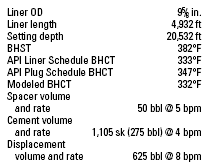 |
|
The specifications for the 9 5/8-in. drilling liner are typical of large-OD liner where a high-volume, high-rate job design is appropriate, and where the API Liner Schedule can be applied.
Liner job 1. Several job parameters were included in the modeling: interval drilling days, average circulating rate, time required to pull out of the hole, time required to run the liner in the hole, ambient surface temperature, fluid inlet temperature, fluid viscosity, the circulation rate and circulation duration with the liner on bottom.
As demonstrated in the graph, Fig. 1, the BHCT is lower on the 9 5/8-in. liner because of the volume, rate, and annular clearance. With a larger annular clearance the pump rates can be higher without exceeding the fracture gradient and, since the cement volume is much greater than on a small liner, the cement temperature actually helps lower BHCT.
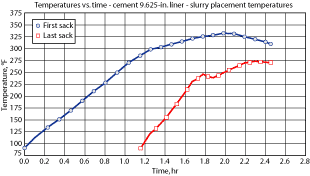 |
Fig. 1. In liner job 1, the temperature spread is wide, because the 9 5/8-in. liner, annular clearance, cement volume and pump rate were based on the API Liner Schedule.
|
|
Liner job 2. In this example, the liner size and resulting annular clearance, the cement volume, and the pump rate are all significantly lower than those associated with the 9 5/8-in. liner, Table 3. With a smaller OD liner, the cement is in place before the BHCT can drop to API Liner Schedule BHCT. The API Plug Schedule BHCT correlates almost exactly with the modeled BHCT, Fig. 2. If testing was performed using the API Liner Schedule BHCT, the resulting slurry pump time would have been much lower than the desired pump time for the job.
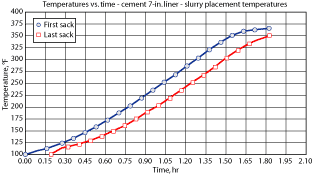 |
Fig. 2. In the same wellbore on liner job 2, the 7-in. liner and resulting annular clearance, cement volume, and pump rate were all lower than for liner job 1. It resulted in a narrower temperature spread and correlated with the API Plug Schedule.
|
|
| TABLE 3. Liner job 2: 7-in. liner (low volume, low rate) |
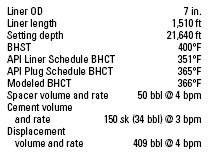 |
|
The job summaries show how testing based on the API Liner Schedule rather than the API Plug Schedule can lead to pumping-time underestimation.
Liner job 3. When the cement for this 5-in. liner job was tested using the BHCT from the API Liner Schedule, the amount of retarder seemed adequate to achieve a 5-hr pump time. However, the actual slurry pump time was only 2 hr 45 min. Although the cement job was good and no remediation was required, further post-job testing was conducted to determine why the pumping time was much less than indicated by initial testing.
As shown in Table 4, the API Plug Schedule BHCT is almost identical with the BHCT identified through post-job modeling. Additional retarder (6 gal/100 sk) would have been required to achieve the 5-hr pump time desired on this 5-in. liner job.
Liner job 4. A similar outcome was observed with this 5-in. liner job. A 4-hr pump time was planned based on testing using the BHCT from the API Liner Schedule. The actual job took approximately two hours, leaving little safety margin for mechanical failure or job disruption, Table 5.
| TABLE 4. Liner job 3: 5-in. liner post-job analysis |
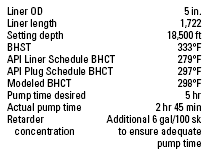 |
|
|
| TABLE 5. Liner job 4: 5-in. liner post-job analysis |
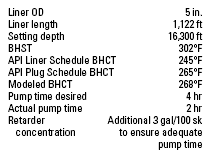 |
|
|
CONCLUSION
These case histories demonstrate that under certain conditions�low volume, low rate, smaller OD liners�basing cement testing and job design on the API Plug Schedule BHCT will provide a much more accurate pump time and help ensure that the cement carries the right concentration of retarder to achieve the pump time desired. 
|
THE AUTHORS
|
|
Jasen Bradley earned a BS degree in electrical engineering from McNeese State University in 2003. His responsibilities include cementing job design, well support and post job analysis. Bradley is a technical professional in the Cementing Product Service Line with Halliburton Energy Services and is a member of the Society of Petroleum Engineers, National Society of Professional Engineers, and Louisiana Engineering Society
|
|
 |
Joey Langlinais has 29 years of cementing experience. He is the technology operations leader in the Cementing Product Service Line with Halliburton Energy Services and works with the Cementing Technology Team at the Customer Service Center in Lafayette, Louisiana. Langlinais covers the offshore GOM, including deepwater areas, land and inland water areas of South Louisiana.
|
|
|












